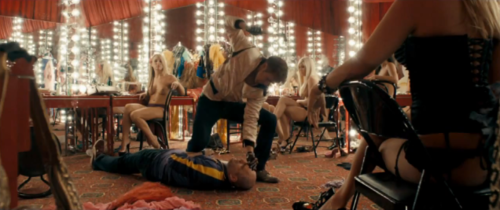Now we see the violence inherent in the system

Everybody's raving about Drive. I'm a week late on it, but I caught up with it yesterday at the Curzon. People are right to rave about it. Nicholas Winding Refn's first American film (after – most famously - the Pusher trilogy, set in his native Denmark, Bronson, made and set in the UK, and Valhalla Rising, a Denmark/UK co-production) is a neo-noir in the Tarantino mould which which plays its LA-set criminal comings and goings much straighter. It is, therefore, much more disturbing.
The trailer hints at such (the scene with the hammer and the showgirls pictured above is in the trailer), but until you see it, you can have no idea just how violent it is. To the degree that I feel I should actually put out a warning: the violence in this film is pretty horrible. You know me – I'm fairly squeamish, but this has never stopped me seeing violent films, and many of my favourite films have violence in them. I just think it's worth knowing in advance, as you might think you'll be watching a stylish thriller with some driving in it. You will be, but, once a certain dramatic flashpoint is reached, you'll also be on a rollercoaster of violence. It is the kind of violence where the camera does not discreetly look away. It is the kind of violence that is often enacted in broad daylight. It is the kind that involves sharp implements going into flesh and shotguns fired at close range, but also the kind that is more primal and shall-we-say impact-based. (That's the kind I'm finding I have less of a stomach for, as it becomes more and more fashionable. The big display of violence in the excellent Kill List is impact-based.)
In many ways, Drive is about violence, even though its first hour builds up to the flashpoint with patience and calm and subtlety. I say that because it's not really about much else. It's a fairly standard crime story revolving around a holdall full of money and double-cross and threats and revenge, albeit one that's elevated by its selling point, and the selling point, presumably, of the source novel: Ryan Gosling's supercool and unnamed driver. He works as a stunt double and car mechanic by day, and as a getaway driver by night. He does this in his trademark silver bomber jacket with a scorpion emblem on the back and his trademark leather driving gloves, and with his trademark toothpick held in the corner of his mouth. He is beyond cool. Gosling plays him beautifully. He's in the business of crime, but he just drives, and is thus, in some wishful way, innocent. In the opening robbery, we see him just walk away from the scene once his work is done. Heading up a superb and offbeat supporting cast, Bryan Cranston from Breaking Bad is his limping, good-hearted enabler and handler. Albert Brooks and Ron Perlman are the local gangsters, one calm, the other hot-headed (although it's always the calm ones you have to watch out for in this kind of drama). Carey Mulligan is the young mother next door whose husband is in prison, but whose husband comes out of prison just when she and Gosling – and her little boy – are forming a happy little unit. The bad stuff goes from there. (Oh, and Christina Hendricks from Mad Men totters through all top-heavy on her high heels all too briefly, but it's another clever bit of casting.)
So, it has this sweet little love story at its centre, and Gosling and Mulligan pull this off with easy realism, all glances and gestures and mounting passion that remains largely unconsummated. If they have sex, you don't see it. This is so restrained on Winding Refn's part. Apart from the topless showgirls watching the violence in the above still, there is no sex on view here. He pulls back from sex, but does not pull back from violence. Violence, it seems, is more important to the narrative.
I came away full of admiration for this film. It's a very impressive film. It's framed exquisitely, with characters nearly always ranged left or right in the panorama. The soundtack, by Cliff Martinez, is all pulsing 80s synth (a faux-period illusion supported by the pink, hand-written credits), and if it weren't for the mobile phones, you'd swear it was set in the past. This is a classic, almost timeless LA, one that verges on cliché but wilfully, with its neon, and its freeways, and its diners, and its underground car garages, and its vast lots. Winding Refn's nationality – he's Danish but moved to the US and was educated there – explains this idealised, artificial attitude to the city. It's as if it's been shot through a prism of previous American cinema.
I'm not sure there's much else to Drive beyond a soundly constructed crime yarn with its attendant domestic impacts and some brutally inventive set-pieces. But the getting there is amazing.








Andrew Collins's Blog
- Andrew Collins's profile
- 8 followers



